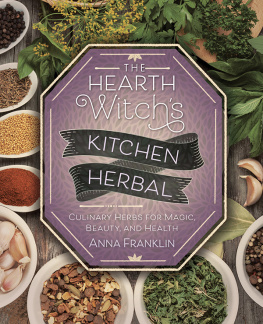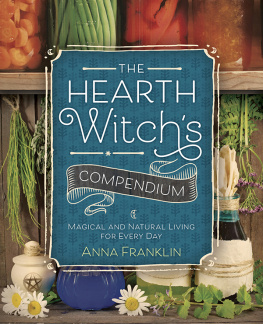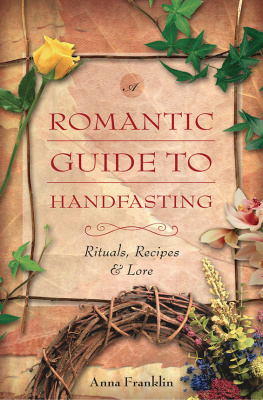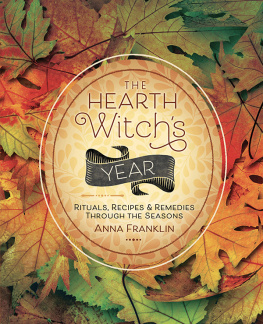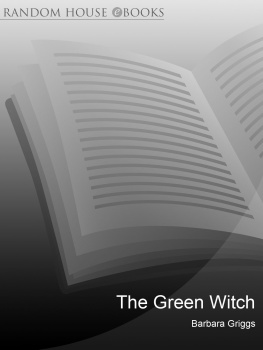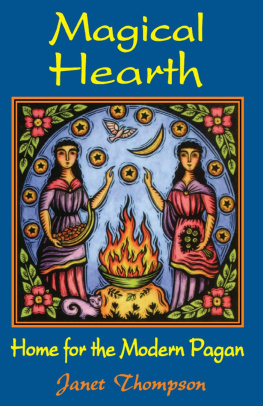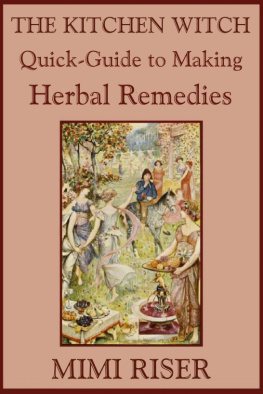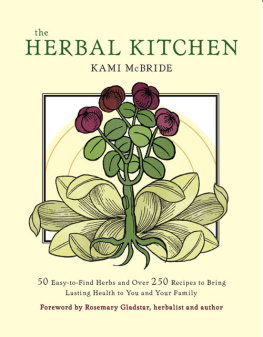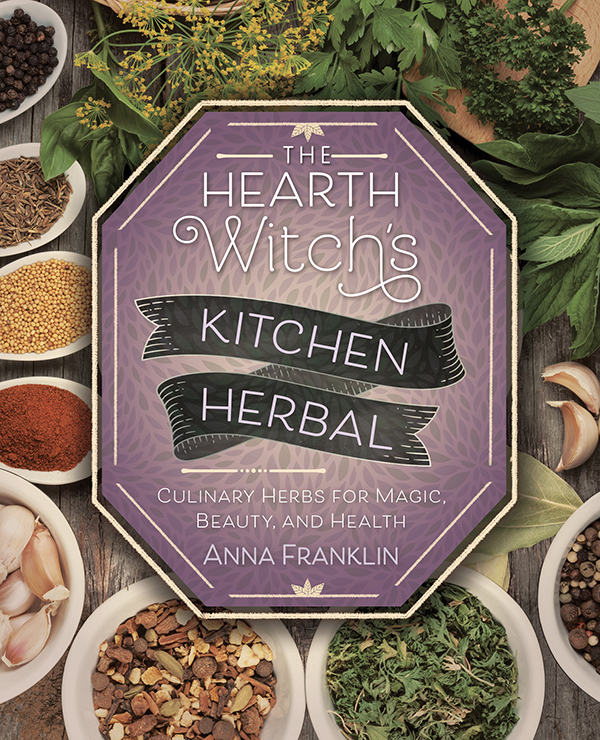A nna Franklin is a third-degree witch and high priestess of the Hearth of Arianrhod, and she has been a practicing Pagan for more than forty years. She is the author of thirty books and the creator of the Sacred Circle Tarot , Fairy Ring Oracle , and the Pagan Ways Tarot (Schiffer, 2015). Her books have been translated into nine languages.
Anna has contributed hundreds of articles to Pagan magazines and has appeared on radio and TV. She lives and works in a village in the English Midlands, where she grows her own herbs, fruit, and vegetables, and generally lives the Pagan life. Visit her online at www.AnnaFranklin.co.uk .

Llewellyn Publications
Woodbury, Minnesota
Copyright Information
The Hearth Witchs Kitchen Herbal: Culinary Herbs for Magic, Beauty, and Health 2019 by Anna Franklin.
All rights reserved. No part of this book may be used or reproduced in any matter whatsoever, including Internet usage, without written permission from Llewellyn Publications, except in the form of brief quotations embodied in critical articles and reviews.
As the purchaser of this e-book, you are granted the non-exclusive, non-transferable right to access and read the text of this e-book on screen. The text may not be otherwise reproduced, transmitted, downloaded, or recorded on any other storage device in any form or by any means.
Any unauthorized usage of the text without express written permission of the publisher is a violation of the authors copyright and is illegal and punishable by law.
First e-book edition 2019
E-book ISBN: 9780738758237
Book design by Rebecca Zins
Cover design by Shira Atakpu
Llewellyn is a registered trademark of Llewellyn Worldwide Ltd.
Library of Congress Cataloging-in-Publication Data
Names: Franklin, Anna author.
Title: The hearth witchs kitchen herbal : culinary herbs for magic, beauty,
and health / Anna Franklin.
Description: Woodbury, Minnesota : Llewellyn Publications, [2019] | Includes
bibliographical references and index.
Identifiers: LCCN 2018057738 (print) | LCCN 2019001673 (ebook) | ISBN
9780738758237 | ISBN 9780738757896
Subjects: LCSH: Witchcraft. | HerbsMiscellanea. | HerbsTherapeutic use. |
Formulas, recipes, etc.
Classification: LCC BF1566 (ebook) | LCC BF1566 .F695 2019 (print) | DDC
133.4/3dc23
LC record available at https://lccn.loc.gov/2018057738
note : The information in this book is provided for educational and entertainment purposes only. It does not constitute a recommendation for use.
Llewellyn Publications is an imprint of Llewellyn Worldwide Ltd.
Llewellyn Publications does not participate in, endorse, or have any authority or responsibility concerning private business arrangements between our authors and the public.
Any Internet references contained in this work are current at publication time, but the publisher cannot guarantee that a specific reference will continue or be maintained. Please refer to the publishers website for links to current author websites.
Llewellyn Publications
Llewellyn Worldwide Ltd.
2143 Wooddale Drive
Woodbury, MN 55125
www.llewellyn.com
Manufactured in the United States of America
Contents
appendix 1:
appendix 2:
appendix 3:
appendix 4:
appendix 5:
appendix 6:
Introduction
T he Hearth Witchs Kitchen Herbal is a herbal with a difference: it looks at the herbs and spices most of us already have in our kitchens and shows how they can be used for home remedies, personal care, spiritual practice, and magic.
I often visit Pagan conferences, markets, and camps, where I meet people looking around for the hottest trend or the latest magical or healing ingredient, and the rarer and more expensive it is, the more magical and useful they think it must be. This is nothing new. The spices we use daily for cooking were once extremely costly and rare, coming from faraway, exotic places, and because of this people scrabbled to get hold of them, believing they had mystical properties and greater healing powers than the herbs that grew at homeand sometimes this was true. It is hard to imagine now, but the black pepper you sprinkle on your dinner every evening was once one of the most valuable commodities in the world, worth its weight in gold because of its medicinal properties and culinary piquancy. When Christopher Columbus set sail on his voyage of exploration, it was to find a new route to get black pepper cheaper, but he landed in the New World and found chilli peppers instead. Other spices were so mysterious, they were thought to have magical origins. Cinnamon was believed to grow in deep glens guarded by deadly snakes, where the legendary phoenix birds built nests from it, immolating themselves so that they might emerge reborn from its ashes. Naturally, this story justified the exorbitant prices that traders charged for it.
For our ancestors, plants were a wonderful treasure trove of natural resources that could be employed for food and medicine or be used to provide clothing, furniture, and building materials. However, it was also believed that they had a spiritual quality, and their employment in magic and religious practice was equally important.
Herbs and spices have been examined, tested, classified, and written about for millennia. Early herbals generally included the spiritual and magical aspects of plants as well as their uses in healing, and most of our knowledge on how our ancestors used plants comes from these. The earliest known herbals are the Chinese Shennong Bencao Jing, or Great Herbal (2700 BCE); the Sushruta Samhita, which documents the teachings of Ayurveda (traditional Indian medicine) and dates back to the second millennium BCE; and the Egyptian Papyrus Ebers, which dates to 1550 BCE but is believed to be based on sources two thousand years older. Several Greek and Roman herbals are still extant, and modern doctors still take the Hippocratic oath, which comes from the Greek herbalist Hippocrates (460377 BCE), often called the father of medicine. Theophrastus (371287 BCE), another Greek, founded the science of botany with his careful observations on plant growth, habitat, and distribution, documented in his Historia Plantarum and De Causis Plantarum (On the Causes of Plants). The De Materia Medica (On Medical Materials), written by the Roman army doctor Dioscorides around 65 CE, served as the model for herbals and pharmacopoeias for the next thousand years and was used right up to the Renaissance. A valuable resource on the ritual use of plants in the classical world is from Pliny the Elder (2379 CE), whose comprehensive Naturalis Historia details plants, their medical uses, and their myths and legends.
The tradition of growing and using herbs in the west continued in the monastery gardens of Christian monks and nuns, who used their knowledge to heal themselves and the local community. One nun, the abbess Hildegard von Bingen (10981179 CE), became well known for her herbal healing ability, based on her study of classical texts and hands-on experience. She documented this in two books, Physica and Causae et Curae . When printing made books more affordable, the less wealthy could buy their own copies of herbals and make their own remedies. John Gerards Herball of 1597 and Culpepers Complete Herbal by Nicholas Culpeper (1653) are still in print.
How to Use This Book
In this book you will find guidance on making home remedies in your kitchen and learn how to prepare teas, tinctures, infused oils, electuaries, oxymels, and balms. There are also instructions on making and using personal care products for your face and hair, and some different ways of incorporating herbs into your magical and spiritual practice.

